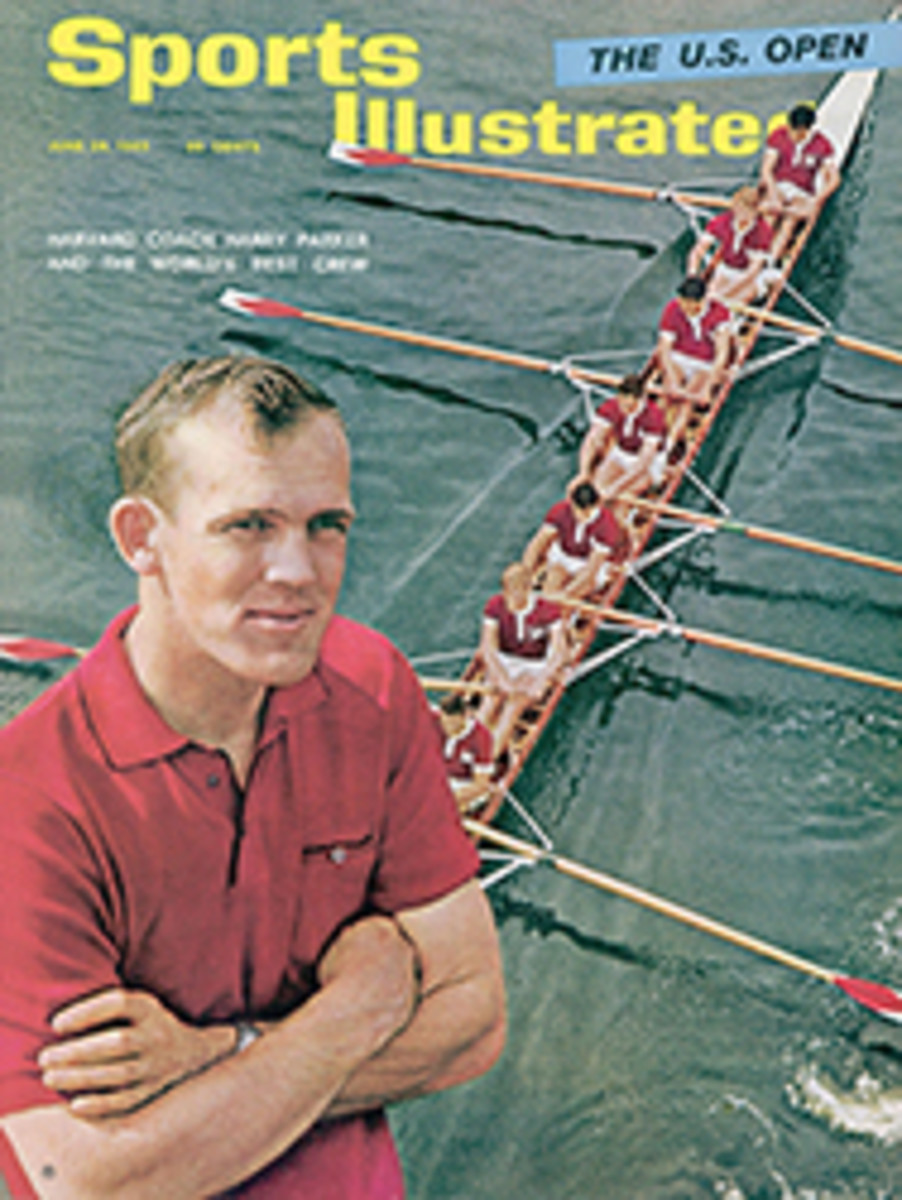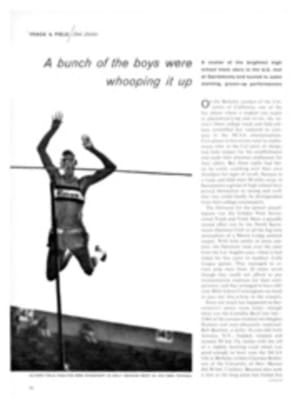
IT WAS MURDER ITALIAN STYLE
Two of the world's more fascinating capitalists are Enzo Ferrari and Henry Ford II. Enzo builds deluxe touring cars and swift racing machines in a tiny Italian factory. Henry, boss of an industrial empire with assets of $6 billion, builds racing cars, too. Last week the motoring world was on tiptoe for what was billed as a titanic struggle between these men for victory in the classic French sports car race, The 24 Hours of Le Mans. Henry, spending like a Ford, flung six sexy new GTs into the battle. Enzo, reaching for his sixth consecutive Le Mans triumph, countered with four factory prototypes and had in private hands seven other brisk models bearing his famous prancing horse emblem.
As Ford knew, every previous thrust for a Le Mans victory by an American car had failed. There were attempts by Stutz, Chrysler, Overland, Willys-Knight and DuPont between the wars. The highest any of these cars placed was second—a Stutz in 1928. Then in the 1950s the American sportsman Briggs Cunningham attacked with Chrysler-and Cadillac-engined racers designed especially for him. Cunninghams placed third twice and won much goodwill for America but never came close to snaring the first prize.
"This is now a 100% battle," said Ferrari Driver Mike Parkes, a Briton who also works as a Ferrari engineer. "A Ferrari win is important not only for the prestige of Ferrari but also for Italy and the Italian car manufacturers."
The battleground—a rectangular 8.36-mile ribbon of asphalt stretching over rolling country just outside of town—annually imposes a fearful strain on cars and drivers. Engines overheat and tear themselves apart, gearboxes shatter, axles crumble. Drivers fight fatigue and, more often than not, rain or fog rolling in during the long hours of darkness.
The weather was fine for a change last weekend, but so frantic was the battle that not one factory Ferrari or Ford made it through the 24 hours. It was a glorious outing for Enzo Ferrari nevertheless. Three of his privately owned racers rolled across the finish line at 4 p.m. Sunday in tight formation, sweeping the top places, and in the Ford pit Team Manager Carroll Shelby moaned, "It's a bad day at Black Rock."
Out of the winning car stepped a jaunty little American, Masten Gregory, blinking like Mr. Magoo behind heavy specs and grinning hugely, for this was his first real blockbuster of a victory in 13 years of racing. He gulped champagne on the victory stand with Co-driver Jochen Rindt of Austria, one of those unknowns who sometimes surface in Le Mans-style endurance races.
Gregory, a man with the weakest eyes and fanciest tastes in racing, knows tough racecourses and fine restaurants on five continents. As a young driver with more foot than finesse, he cheerfully went through his $500,000 share of a family insurance fortune. He bounced from one racing team to another and won fame of a sort for twice bailing out of crashbound racers at better than 100 mph. Although he never lost the nasal twang of his native Kansas speech, he long ago deserted the Midwest for the more cosmopolitan life of London and Paris, and he is as familiar with the wine list at a small but sumptuous two-star restaurant near Le Mans as with the Arnage and White House corners of the racecourse.
During the prerace scuffling between Ford and Ferrari, however, Gregory was all but ignored. The star of the Ferrari camp was Britain's world champion Grand Prix driver, John Surtees. He was not notably alarmed by the fact that two Ford GTs boasted the largest, most powerful engines in the race—seven liters of piston displacement against four liters for the biggest Ferrari. Reviewing the Ferrari sweep of 1964, he said, "Basically, the car that won wasn't going the fastest, but it kept going while the others had silly troubles." Surtees calmly ate dinner while a howling storm blew out a practice session scheduled for Wednesday evening and rattled the windows a few feet from his table. "I'll have to get out my slide rule," he said, "and check on the flexibility of glass."
In the Ford encampment Shelby huddled frequently with his ace, Phil Hill, the world champion for 1961 and three times winner of Le Mans for Ferrari. First practice runs revealed a tendency of the GTs to fishtail. "If we could get them a little more stable," said Hill, "we could go like a bat out of hell." Shelby had some fins bolted to the Fords' noses, and Hill thereupon shattered the lap record with a run of three minutes 33 seconds, hitting better than 200 mph on the long Mulsanne straight. "Whatever's been done," he exclaimed, "it's great. It's a beauty. I could drive the car that fast for 24 hours."
At 4 o'clock Saturday afternoon, with the usual enormous Le Mans crowd of 300,000 at trackside, French Sports Minister Maurice Herzog dipped the starting flag and 51 drivers sprinted to 51 silent cars, started engines and sizzled away in the indescribable traffic jam characteristic of Le Mans races.
One of the big Fords, driven by New Zealander Chris Amon, was first up the track. With one lap completed, he was trailing his countryman Bruce McLaren, who had the lead in the other seven-liter Ford. For the first hour these two American machines set a scorching pace. Then the Fords began to fizzle. GT Driver Maurice Trintignant was out after an hour. Phil Hill took over from Co-driver Amon and was soon forced into the pits by gear-selector trouble, which took 41 minutes to fix. At the end of the second hour five Ferraris were running ominously behind the McLaren-Ken Miles GT, and then pop! went two other GTs, victims of overheating. No sooner had these retired than the leading Ford perished on the Mulsanne straight from gearbox failure. Next to expire was the GT of Britain's Sir John Whitmore and Innes Ireland, also from overheating.
These calamities left the now hopelessly outdistanced Hill-Amon Ford as the last Dearborn contender, and shortly before 11 it was gone, too, clutchless and abandoned by Amon at the end of the Mulsanne straight. It had completed 90 laps, and in it Hill had set a new racing-lap record of three minutes 37.5 seconds (139.251 mph).
After the first three hours there were never fewer than three Ferraris in front, and at one point Ferraris had the first six positions. It is an axiom of Le Mans racing that when some Ferraris fail there is always a healthy one around to finish first, and this was the case last weekend. Late Saturday night the attrition of factory Ferraris began when Surtees pulled in with a broken spring. In the early hours of Sunday morning all the team cars required time-squandering repairs on new—and evidently unproved—radially cooled brake discs, which were cracking.
Carroll Shelby still had hopes for a smashing victory in the big-engined Grand Touring class for his Ford-powered Cobras, but now they, too, began to go the way of the faster GTs. Within six hours four of the five Cobra starters were out because of engine trouble. The fifth Cobra ultimately finished in eighth place. Driven by Britain's Jack Sears and the American racing dentist, Dick Thompson, it was the sole survivor of Ford's massive assault.
With the team Ferraris in trouble, a private entry driven by France's Pierre Dumay and Taf Gosselin had led since the eighth hour. It stayed in front until three hours before the finish, when the right rear tire blew. And then the Gregory-Rindt car, entered by Luigi Chinetti (the American distributor for Ferrari and an old Le Mans hand, having won the race himself three times), stormed ahead to stay. This was a smaller-engined car of only 3.3 liters. It was Gregory's ninth Le Mans, the very first for Rindt.
Those in the crowd familiar with Gregory's reputation for asking just a little more of a racing car than that car is able to give, and remembering that he had catapulted from 32nd place in the Indy 500 all the way to 14th only to fracture an oil line, kept fingers crossed for him Sunday. They needn't have bothered. He lightfooted it in coolly and securely, having covered 2,906.2 miles at an average speed of 121.1 mph.
Swallowing hard, a Ford executive said, "Success in motor racing requires great perseverance and painstaking effort. We are prepared to go forward on that basis."
PHOTO
Friendly foes Carroll Shelby of Ford and Ferrari's Masten Gregory chat before race.
PHOTO
Victory-bound Ferrari coupe of Gregory and Rindt corners smoothly at dusk on first day.

